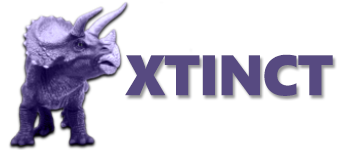Why is XTINCT Necessary?
Years ago, disk media inside a glass house, accessed by only a few people and password protected was considered reasonably safe. Even disaster recovery testing at offsite locations didn’t raise much concern for the safety of corporate data. After testing, many would scratch the table of contents and walk away feeling corporate data was reasonably safe. Today, however, is a different story.
Terrorism, identity theft, off-shoring, outsourcing, litigation, the Internet and the global economy have all highlighted the need for increased data protection. Governments have passed legislation such as Sarbanes-Oxley, HIPPA and Gramm-Leach-Bliley to hold corporations responsible for securing private information under their care. Beyond government standards, industry regulations such as the Payment Card Industry Data Security Standard have further defined the rules, and corporations desiring to do business with them must be in compliance. Other techniques to render the data unreadable like encryption may appear to be adequate but still not good enough for your liability insurance. Failure to comply with these standards for data protection can result in large business losses and severe penalties; so it is no longer simply a matter of due diligence to protect data under your control – it is a necessity.
XTINCT meets DOD standards for erase
XTINCT meets all the requirements of US Department of Defense 5220.22-M (Clearing and Sanitization Matrix for Clearing Magnetic Disk) by overwriting all addressable locations with a single character. XTINCT also meets the sanitization requirement by overwriting all addressable locations with a character, its complement, then a random character and verifying. For tapes, the DoD only considers degaussing or pulverizing the tape to be a valid erase. XTINCT meets the requirements of most users by overwriting the tape and use of the hi-speed data security erase patterns.
When is it necessary?
- When moving disks to another location.
- When disks come off lease and are being returned to the vendor.
- When disks are being moved to a warehouse.
- When leaving a backup/recovery site after disaster recovery testing.
- Before re-using disks for a different group within the company.
- Before scrapping disks.
Are there any free products available to Clear or purge Data?
The short answer is NO. With utilities such as IEHPROGM, individual data sets or the entire VTOC can be scratched. However, that simply removes the pointer to each data set while leaving all the data on the disk. ICKDSF can perform a MINIMAL INIT to create a label and a new VTOC, but that leaves all the data on the disk as well. A MEDIAL INIT will re-write the Home Address and record zero but may still not render data unreadable. Consequently, it will not satisfy the standard for clearing or purging. These techniques also take a VERY long time.
XTINCT: DSF/E Device Support Facilities/Extended
For all of the aforementioned reasons, DINO-Software Corporation has developed XTINCT; this software can help even the most demanding corporations meet their security needs.
- XTINCT has 5 primary commands: DISKINIT, DSINIT DSINITT, DSINITV and TAPEINIT.
- DISKINIT to erase full 3390 disk volumes.
- DSINIT to erase sequential and partitioned disk datasets.
- DSINITT to erase tape data sets.
- DSINITV to erase VSAM data sets.
- TAPEINIT to erase tape data sets.
- XTINCT is reentrant and fully supports subtasking. Up to 64 volumes can be processed asynchronously. Other tools, like ICKDSF run serially.
- XTINCT makes extensive use of channel programs. Many functions operate at peak efficiency by only using enough CPU time to generate the channel programs, with the rest of the operation being carried out by the channel subsystem. This makes XTINCT a miser when it comes to valuable CPU time.
- Control statements allow for PACING the number of concurrent operations against a string using the TASKMAX parameter. The user can run one task or many at the same time.
- XTINCT provides four levels of erasing data to satisfy the needs of even the most demanding customers.
- XTINCT provides a pattern write that reverses each bit (one’s compliment) to eliminate the possibility of reading residual data.
- To make sure that the data pattern is written to disk, XTINCT forces the storage controller to de-stage all modified tracks at the end of each pass and prior to starting the next one. This precludes a second pattern replacing the first pattern in cache and never being written to the disk, while still making efficient use of NVS and cache.

